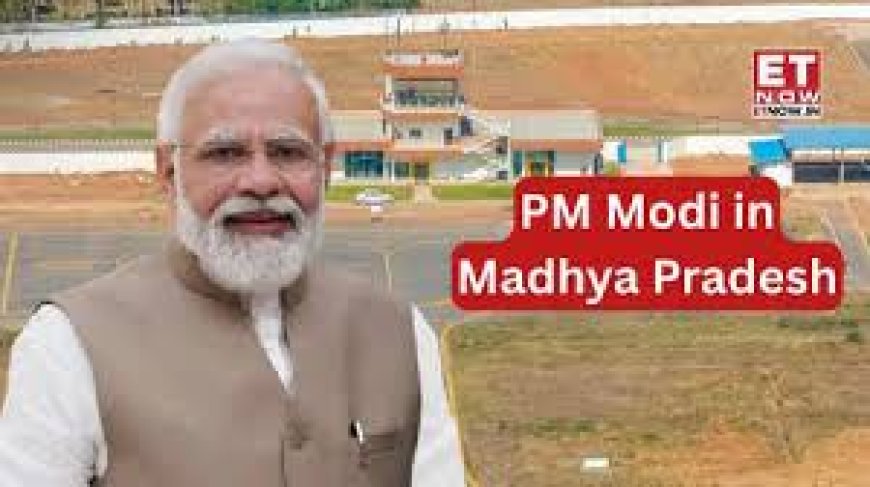PM Modi Inaugurates ₹15,000 Cr Development Projects in Madhya Pradesh
Prime Minister Narendra Modi launches infrastructure and welfare projects worth ₹15,000 crore in Madhya Pradesh, boosting economic prospects and investor sentiment in the region.

Bhopal, India — May 31, 2025:
In a significant boost to regional infrastructure and welfare, Prime Minister Narendra Modi inaugurated a slew of development projects worth over ₹15,000 crore in Madhya Pradesh on Saturday. The initiatives, spanning sectors including transport, healthcare, and rural development, underscore the government's commitment to inclusive growth and infrastructural modernization ahead of the 2025 state assembly elections.
A Multifaceted Development Push
At a grand event held in Jabalpur, PM Modi laid the foundation stones and inaugurated several high-impact projects. These included new railway lines, expressways, AIIMS expansion units, drinking water schemes, and smart city infrastructure.
“Madhya Pradesh is witnessing unprecedented development under our vision of ‘Viksit Bharat’,” said PM Modi while addressing a large gathering. “These projects are not just about infrastructure but about empowering every citizen—from farmers and youth to entrepreneurs.”
The key projects include:
-
Expansion of Jabalpur AIIMS facilities
-
Inauguration of a new railway line between Satna and Rewa
-
Foundation stone for four-lane expressway from Indore to Harda
-
Rural drinking water schemes under the Jal Jeevan Mission
-
Smart city command centers in Bhopal, Gwalior, and Indore
Analysts See Positive Economic Ripple Effects
Market and policy analysts have noted the broader implications of the development package, particularly its potential to drive local employment and stimulate ancillary industries.
“The infrastructure spend in central India, especially in a politically pivotal state like Madhya Pradesh, is a strategic move both economically and electorally,” said Radhika Mehra, Senior Economist at India Equity Research. “Improved connectivity and healthcare infrastructure in tier-2 and tier-3 cities can accelerate regional GDP.”
The improved road and rail connectivity is expected to cut freight time and logistics costs for industries in the cement, agriculture, and textile sectors prevalent in Madhya Pradesh.
Market Context: Infrastructure and Election Linkages
With the national elections a year away and state polls looming, the Modi government is pushing for tangible achievements in BJP-ruled states. The emphasis on infrastructure is also aligned with the central government’s ₹111 lakh crore National Infrastructure Pipeline (NIP), which seeks to modernize India’s roads, railways, ports, and energy sectors.
Investors and businesses are eyeing this move as a green signal for stable policy support in manufacturing and logistics.
“The synergy between political stability and economic vision is attractive to institutional investors,” said Ashok Rathi, Portfolio Manager at MidCap India Fund. “We expect a short-term boost in construction and capital goods sector stocks due to execution visibility.”
Investor Outlook: Bullish on Infrastructure and Construction
Stock market analysts have noted a mild uptick in investor interest in companies associated with civil construction, cement, and public infrastructure following the announcements. Share prices of listed companies involved in railway and highway EPC contracts have seen marginal gains in the past two sessions.
“This is a clear macro indicator for long-term investors,” said Anita Verma, an equity strategist with Bombay Capital Advisors. “Focus on tier-2 cities and better medical infrastructure will have cascading effects on real estate and urbanization trends.”
The government's focus on expanding AIIMS facilities and water schemes also aligns with broader ESG (Environmental, Social, and Governance) goals, likely to attract FII (Foreign Institutional Investment) attention in the social impact investing space.
Political Undertones Ahead of 2025 State Polls
The visit is being seen as a strategic political outreach in Madhya Pradesh, where the BJP seeks to consolidate its rural and urban voter base. PM Modi’s reference to “double-engine sarkar” — emphasizing development synergy between the state and central governments — was aimed at reinforcing the BJP’s governance narrative.
Opposition leaders, however, criticized the event as “poll propaganda.” Congress spokesperson Rakesh Singh questioned the timing of the announcements, calling it an “attempt to camouflage under-performance.”
Despite the political undertones, public reception at the venue appeared overwhelmingly positive, with massive crowds and local community leaders hailing the projects as “long overdue.”
Looking Ahead: Execution is Key
While the announcements have garnered optimism, much depends on execution timelines and bureaucratic coordination. Past mega-projects have occasionally faced delays due to land acquisition and regulatory clearances.
However, the Modi administration has introduced Project Monitoring Groups and digital dashboards to streamline approvals and track milestones—a move seen as investor-friendly.
“Speed of delivery will determine credibility,” said Swati Kulkarni, Professor of Public Policy at IIM Indore. “If the government sticks to project timelines, Madhya Pradesh could serve as a model for integrated development.”
Conclusion
The inauguration of over ₹15,000 crore in development projects by Prime Minister Modi marks a major push toward economic modernization and social welfare in Madhya Pradesh. For investors, businesses, and citizens alike, the developments signal a proactive approach to regional empowerment, infrastructure-led growth, and election preparedness. All eyes now turn to the speed and efficiency with which these projects move from blueprint to reality.
What's Your Reaction?
 Like
0
Like
0
 Dislike
0
Dislike
0
 Love
0
Love
0
 Funny
0
Funny
0
 Angry
0
Angry
0
 Sad
0
Sad
0
 Wow
0
Wow
0












































































